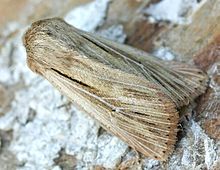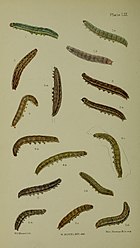Shoulder-striped wainscot
This article includes a list of general references, but it lacks sufficient corresponding inline citations. (October 2021) |
| Shoulder-striped wainscot | |
|---|---|

| |
| Scientific classification | |
| Domain: | Eukaryota |
| Kingdom: | Animalia |
| Phylum: | Arthropoda |
| Class: | Insecta |
| Order: | Lepidoptera |
| Superfamily: | Noctuoidea |
| Family: | Noctuidae |
| Genus: | Leucania |
| Species: | L. comma
|
| Binomial name | |
| Leucania comma (Linnaeus, 1761)
| |
| Synonyms | |
| |
The shoulder-striped wainscot (Leucania comma) is a moth of the family Noctuidae. The species was first described by Carl Linnaeus in 1761. Some authors place it in the genus Mythimna. It is found throughout Europe and in Russia to the west of the Urals.
The forewings of this species share the pale buffish ground colour and prominent venation of other "wainscots" but has much stronger dark markings than most of its relatives, including a thick black basal streak which gives it its common name. The hindwings are dingy grey or brown with lighter fringes.[1]
Technical description and variation
[edit]The wingspan is 35–42 mm. Forewing drab grey, suffused, except along costa and inner margin, and in an oblique fascia-form submarginal area, with blackish, the veins and folds remaining pale; a whitish lunule on discocellular: the pale submarginal fascia externally throw's off pale teeth along the veins to termen, the wedge shaped intervals being filled in with black; a long black streak from base below cell; median vein white, with only a small white spot at end of cell and a minute black point above it; veins whitish with black terminal streaks in the intervals. Hindwing dark greyish, fuscous.[2]

Biology
[edit]This species flies at night in June and July[3] and is attracted to light and sugar.
Larvae are reddish brown, with scattered black clots: dorsal and subdorsal lines black and fine; venter paler; thoracic plate black with three white lines; head brown. The larvae feed on various grasses including Deschampsia and Festuca.[4] The species overwinters as a full-grown larva in a cell beneath the surface of the soil.
The species lives mainly on damp meadows, preferably in mountains and hills. In the Alps, it was found up to at an altitude of 2100 meters.
References
[edit]- ^ Hermann Hacker, László Ronkay and Márton Hreblay: Noctuidae Europaeae vol. 4 Hadeninae I. Entomological, Sorø 2002, ISBN 87-89430-07-7.
- ^ Seitz, A. Ed., 1914 Die Großschmetterlinge der Erde, Verlag Alfred Kernen, Stuttgart Band 3: Abt. 1, Die Großschmetterlinge des palaearktischen Faunengebietes, Die palaearktischen eulenartigen Nachtfalter, 1914
- ^ The flight season refers to the British Isles. This may vary in other parts of the range.
- ^ Robinson, Gaden S.; Ackery, Phillip R.; Kitching, Ian J.; Beccaloni, George W.; Hernández, Luis M. (2010). "Search the database - introduction and help". HOSTS - A Database of the World's Lepidopteran Hostplants. Natural History Museum, London.
- Chinery, Michael (1986, reprinted 1991). Collins Guide to the Insects of Britain and Western Europe.
- Skinner, Bernard (1984). The Colour Identification Guide to Moths of the British Isles.
External links
[edit]![]() Media related to Leucania comma at Wikimedia Commons
Media related to Leucania comma at Wikimedia Commons
- Kimber, Ian. "73.301 BF2205 Shoulder-striped Wainscot Leucania comma (Linnaeus, 1761)". UKMoths. Retrieved 5 July 2019.
- Savela, Markku. "Leucania comma (Linnaeus, 1761)". Lepidoptera and Some Other Life Forms. Retrieved July 5, 2019. Taxonomy
- Lepiforum e.V.
- De Vlinderstichting (in Dutch)
